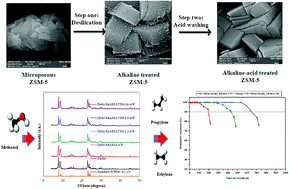Preparation of hierarchical HZSM-5 zeolites with combined desilication with NaAlO2/tetrapropylammonium hydroxide and acid modification for converting methanol to propylene
Abstract
In the present work, mesoporosity is introduced into highly siliceous HZSM-5 zeolites (SiO2/Al2O3 = 400) by a two-step path including desilication using NaAlO2 and TPAOH (tetrapropylammonium hydroxide) mixtures, followed by acid washing treatment. The physicochemical properties of conventional microporous HZSM-5 and all treated samples were characterized by ICP-OES, XRD, FE-SEM, BET and NH3-TPD methods. The catalytic performance of the HZSM-5 samples was determined in methanol to propylene conversion reaction at 460 °C and methanol WHSV of 0.9 h−1 using feed containing 50 wt% methanol in water. The results showed that the porosity of the desilicated samples has been mainly blocked by sodium aluminate derived deposits and silicon-containing debris. After a subsequent acid washing step with hydrochloric acid, the blocking species were removed which resulted in improving the mesoporosity generated in the desilication step. It was found that alkaline-acid treatment in a NaAlO2/TPAOH solution with TPAOH/(NaAlO2 + TPAOH) = 0.4 followed by acid washing, leads to the formation of narrow and uniform mesoporosity without severely destroying the crystal structure. Also, it exhibits higher selectivities to propylene (37.7 vs. 30.7%) and total butylenes (21.2 vs. 16.1%), propylene to ethylene ratio (4.0 vs. 2.7), as well as total light olefins (68.4 vs. 57.9%) compared to the parent catalyst, while its selectivities to C1–C4 alkanes (9.6 vs. 13.7%) and heavy hydrocarbons (13.8 vs. 28.4%) are relatively lower. The lifetime of the optimum alkaline-acid treated sample (640 h) showed a significant increase compared to that of the parent catalyst (425 h). The results exhibited that desilication process leads to a considerable mesoporosity development, while acid washing treatment mostly influences on the catalyst acidity. Therefore, the combination of the alkaline-acid treatment leads to hierarchical HZSM-5 catalyst formation with tailored pore architecture and surface acidic properties.



 Please wait while we load your content...
Please wait while we load your content...